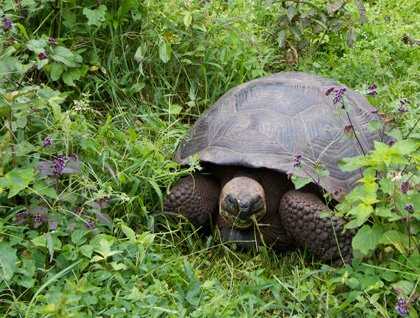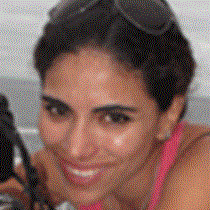Just before dawn, we reached Academy Bay at the southeastern corner of Santa Cruz Island and here Captain Pablo Garces had our boson drop the anchor of the National Geographic Islander. Academy Bay is named after the California Academy of Sciences, which supported important scientific collecting expeditions to the Galápagos during the early 1900s. The largest town in the islands is Puerto Ayora, home to about 22,000 inhabitants who are fishermen and farmers or work in tourism. Puerto Ayora is also home to both the Galápagos National Park Service and the Charles Darwin Research Station.
This morning, following yet another delicious breakfast (eggs benedict this time!) we disembarked at the National Park Service dock and walked to the giant tortoise breeding center, a joint program of the park service and research station. The program has been an extremely successful, and we enjoyed seeing dozens of tiny hatchling tortoises. We learned about “Super Diego,” a male tortoise that was taken from the southern island of Española but returned years later when scientists realized his species was close to extinction. In the decades since his return, Diego has been a champion breeder. From a mere 15 surviving adult tortoises (only three of them males, including Diego), we now have a healthy wild population of more than 2,000!
After our visit to the research station, we followed the coastal road through town at our own pace, shopping for souvenirs and T-shirts in the many colorful boutiques. At the small fish market we snapped photos of the fisherman sorting and selling their fish and lobsters while juvenile pelicans begged for scraps. We gathered at The Rock café for a glass of juice and then boarded buses with our guides to head into the highlands. Ruly escorted 13 bike riders who pedaled and panted up and down damp, rolling hills and met us—slightly mud splattered—at “El Trapiche.” This is a family-run coffee and sugarcane plantation where we learned about their simple processing techniques and enjoyed tasting their products. The fresh squeezed sugarcane juice was delicious with a dash of bitter orange, and with or without a generous splash of sugarcane liquor!
We returned to our buses and drove to the western slopes of Santa Cruz where we had lunch at the rustic El Chato restaurant. After our meal we had fun taking pictures of one another inside a large empty tortoise shell. Then we drove to a lower section of farmland to search for tortoises in the wild. There were dozens of them and some of the old males were huge! We took many pictures and—and not for the first time this week—were thankful for our digital cameras.
We returned by bus to Puerto Ayora and chose either to further investigate the town and shops or go back to the ship to relax before dinner. This evening our video chronicler Steve Ambroe showed us a preview of his video for the week and we visually reconfirmed that this has been an outstanding expedition. We have enjoyed a stimulating mix of hikes, Zodiac rides, kayak and snorkeling outings, and have seen magnificent wildlife ranging from the tiny endemic lava lizards, elegant and varied seabirds and unique reptiles, and culminating with orcas and sperm whales! These Islas Encantadas (Enchanted Islands) are indeed magical and we all feel privileged to have had the opportunity to explore them. Sadly, tomorrow is the final day of this expedition; but we excited to see another seabird species that we have not seen thus far—red-footed boobies!









